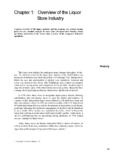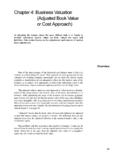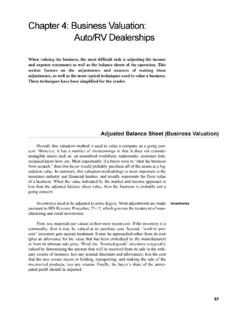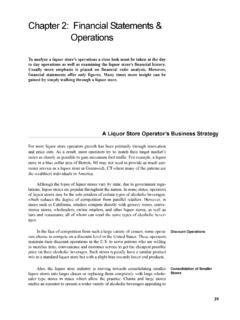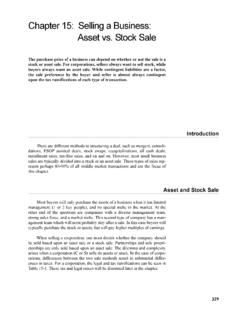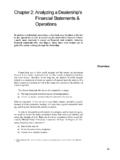Transcription of Chapter 4: Liquor Store Business Valuation - frazier …
1 77 Chapter 4: Liquor Store Business Valuation In this section, we will utilize three approaches to valuing a Liquor Store . These approaches are the: (1) cost (asset based), (2) market, and (3) income approach. The cost approach section focuses on the adjustments and nuances of making balance sheet adjustments, while the market approach values the subject company based on market multiples. Lastly, the income approach will provide a reality check as to the value of the company based on cash Balance Sheet ( Business Valuation )Overall, this Valuation method is used to value a company as a going con-cern. However, it has a number of shortcomings, in that it does not consider intangible assets such as: assembled workforce, trademarks, customer lists, technical know how, etc. Most importantly, if a buyer were to start the Business from scratch, then this buyer would probably purchase all of the assets at a liq-uidation value (see Table 6-2 on page 119).
2 In summary, this Valuation method-ology is most important to the insurance industry and financial lenders and usually represents the floor value of a Business . As an example of an adjusted book methodology, look at Table 4-1 on page 78 and compare the adjusted book value of $248,544 ($175,968 + $5,376 + $67,200) for the total invested capital to the values concluded by the market approach (see Table 4-2 on page 79), and the concluded value of the income approach in Table 4-6 on page 84. It must be noted that not all companies indi-cate such a range in the adjusted balance sheet method, goodwill should also be factored in. Most companies sell for their adjusted book value plus a premium of zero to two times EBITDA. For our subject company, this would result in a premium (goodwill value) of an EBITDA of $39,183 multiplied by to equal an addi-tional $58,774 of value. Total invested capital would equal $307,318 ($175,968 + $5,376 + $67,200 + $58,774) and after subtracting out the $72,576 of interest bearing debt, the equity value would be $234,742 ($175,968 + $58,774 in adjusted goodwill).
3 Liquor License ValueOur subject s Liquor license was purchased recently, and the book value reflects the fair market value of the license. This value reflects the going rate for Liquor Store Business Valuation78such licenses in a quota system and can change from year to year. It is important to contact a broker knowledgeable with Liquor licenses for a given area to obtain an accurate estimate of value. Values vary greatly on projections of demograph-ics, quotas per thousands of people, Business growth trends, and public percep-tion of Liquor stores . It is often the case that developing areas will see higher prices paid for Liquor general idea as to the going rates in various states with quota systems can be seen in Table 2-5 on page 4-1: Sample Adjusted Balance Sheet Book ValueAdjustmentMarket Va l u eAssetsCash & Equivalents$5,384-$5,384 Accounts Receivable 1,200 -1,200 Inventory 94,000 (3,000)91,000 Other Assets---Total Current Assets 100,584 (3,000)97,584 Fixed AssetsMachinery & Equipment 107,000 (42,000)65,000 Market Value of Real Estate---Total Fixed Assets107,000(42,000)65,000 Depreciation (59,250)59,250-Net Fixed Assets 47,750 17,25065,000 Other Assets*135,000-135,000 Total Assets $283,334 $14,250$297,584 LiabilitiesCurrent LiabilitiesAccounts Payable 47,040 2,00049,040 Current Portion Long Term Debt 5,376 -5,376 Other Current Liabilities---Total Current Liabilities 52,416 54,416 Long Term Debt 67,200-67,200 Total Liabilities 119,616 2,000121,616 Stockholder s Equity 163,718 (12,250)175,968 Total Equity & Liabilities $283,334 $14,250$297,584*Other Asset would be the Liquor licenseMarket Approach-Use of Publicly Traded Securities ( Business Valuation )
4 Buyers often use market multiples (from the stock market) to determine a value of a company which they want to value; however, in the case of Liquor Liquor Store Business Valuation79stores, due to varying regulatory measures by each state in the , there are no publicly traded Liquor stores . Because of this, a Valuation based on market com-parables cannot be made, and other methods need to be Valuation of Small Companies ( Business Valuation )As mentioned earlier, this book defines a small Business as one which has sales of less than $10,000,000. Using publicly traded companies is useful, but they are still different from larger capitalized companies. Most large cap compa-nies are publicly traded and therefore bear large 4-2: ODCF MULTIPLESP retax Earnings $22,383 Plus: Depreciation & Amortization11,850 Plus: Interest Expense (Operation Debt net of Real Estate)4,950 Plus: Interest Expense (Real Estate Debt)0 Unadjusted EBITDA39,183 Plus: Owner s Salary20,319 Plus: Actual Rent46,105 Less: Fair Market Rent**(51,840)Owner s Discretionary Cash Flow53,767 Times: Multiplex Value Subtotal166,678 Actual Operating Current Assets100,584 Actual Operating Current Liabilities*(47,040)Plus: Net Working Capital Position53,54453,544 Total Invested Capital220,222 Less: Long Term Debt and Current Portion(72,576)Net Equity Value$147,646 REVENUE MULTIPLESR evenue $350,315 Times: Multiple x Unadjusted Value 136,623 Plus: Net Working Capital Position53,54453,544 Total Invested Capital190,167 Less.
5 Long Term Debt and Current Portion(72,576)Net Equity Value$117,591* Current liabilities do not include current portion of long term debt. Financials are taken from Table 2-3 on page 43 and Table 2-4 on page 44.**Rent was determined by actual rent at the time of Valuation (see Table 5-14 on page 103 and Table 5-19 on page 107).Subject Company ODCF CalculationsLiquor Store Business Valuation80As the value of a company approaches the lower end of the range, sales from $0-$10,000,000, the multiples from publicly traded companies become less important to buyers. In summary, publicly traded companies have less risk, greater access to capital markets, and an overall better ability to survive as a going concern. Small Business owners typically try to pass expenses through the company, and pay themselves as much as possible. Therefore, smaller busi-nesses cannot use multiples which are used by publicly traded companies ( , price/earnings, price/book, price/invested capital).
6 In some cases, it is like com-paring apples to s Discretionary Cash Flow (ODCF)As a result of the afore-mentioned, most owners and buyers focus upon general multiples or rules of thumb. The use of an owner s discretionary cash flow analysis is different from the guideline company technique (publicly traded companies). The main difference is that with an owner s discretionary cash flow analysis working capital, non operating assets and the level of inven-tory must be adjusted. The smaller the Business the more that a buyer buys a job ( , a Liquor Store worth less than $200,000). Buying a job simply means that you are only receiving a salary and will not receive a return on your equity. Your equity return is simply your salary. Subject Liquor Store Value Based Upon ODCF MultiplesA summary of the typical discretionary multiples for Liquor stores can be seen in Table 4-3. A summary of the ODCF calculations for our subject Liquor Store can be seen in Table 4-2 on page 79.
7 In this table, adjustments were made to the cash flow to include all operational items net of real estate Company Concluded Value Based on ODCF and RevenueA seen in Table 4-2 on page 79, the concluded value based upon actual sales of comparable Liquor stores is $220,222 for the total invested capital when using ODCF multiples. After subtracting the current and long term portion of the operational debt, the net equity value of the subject Liquor Store is $147,646. Compare the $220,222 and $147,646 concluded values with those indicated by the revenue multiples indication of $190,167 for the total invested capital and $117,591 for equity Valuation (Rules of Thumb)Rules of thumb are useful for establishing ranges for businesses which are worth less than $1,000,000 but are most helpful for small businesses which are less than $500,000 in value. In general, the smaller the Business the more appli-cable the rules.
8 Yet there are problems with rules of thumb. Rules of thumb are usually too general to be applicable to an individual company. When using rules of thumb, these Valuation numbers do not take into account varying types of leases, profit-ability ratios, activity ratios, or other financial measurements that vary from company to company. With that being said, it is important to find truly compara-ble companies when valuing a Business , and to use rules of thumb with caution. For example, the terms of the purchase could affect the multiples, a buyer pay- Liquor Store Business Valuation81ing all cash, or required to pay all cash by the seller, may negotiate a lower mul-tiple. Table 4-3: Liquor Store Business Valuation Rules of ThumbFinancial MeasureMultiple*Revenue ( Business only, no real estate) times ( average)Owner s Discretionary Cash Flow ( Business only, no real estate) to timesEBITDA Multiples ( Business only, no real estate)3 to times*Multiples need to be adjusted for working Approach Example ( Business Valuation )The previous information can now be incorporated into a discounted cash flow using our subject Liquor Store s financial figures.
9 A discounted cash flow takes debt free cash flows expected in the future and discounts them back to present value using an appropriate discount rate, typically known as WACC. The idea is that a dollar tomorrow is worth less than a dollar in the pocket today. Furthermore, since debt has a cost and stockholder s equity has a required return, they affect the value of future cash flows. This method is really only nec-essary if you expect the area of operation to undergo a stage of growth, or popu-lation boom; otherwise, skip to the direct cap analysis for a more simplified Valuation discounted cash flow to the firm model is summarized in Table 4-6 on page 84. This model is not fully comprehensive but is presented in its simplest form in order to illustrate the model s nuances. AssumptionsThe balance sheet and income statement of Table 2-3 on page 43 and Table 2-4 on page 44 from our subject Liquor Store are used in our example.
10 For simplicity, we have assumed that: Increases in debt free working capital are calculated as the difference between the present year s debt free working capital, and last year s debt free working capital. Sales, cost of goods sold, expenses, other income, depreciation, and capital expenditures are grown based upon a conservative estimate of the annual growth rate at 3% for years 1 through 5, with the terminal year assumed to grow at 3% as well. Accumulated depreciation is calculated as last year s total accumulated depreciation plus this year s depreciation. Income is taxed at 40%.
